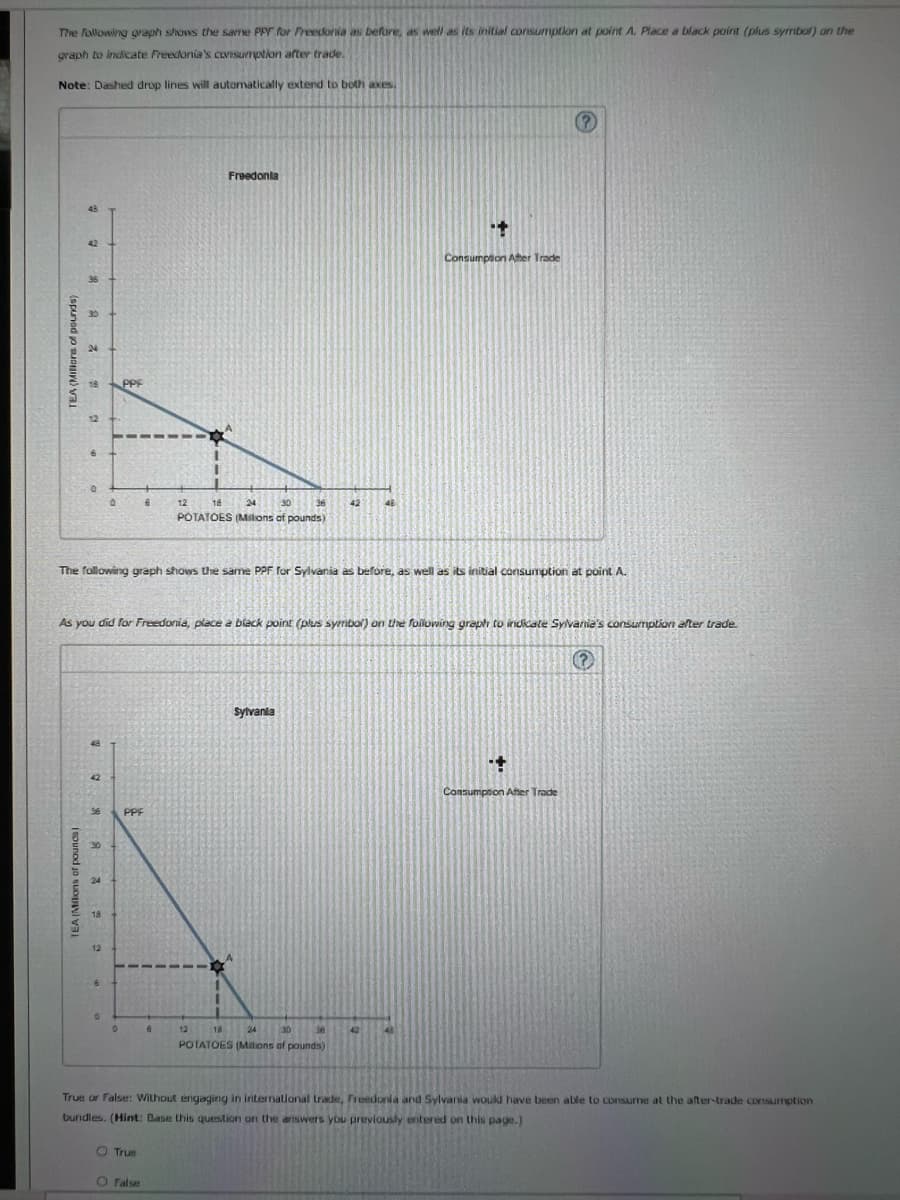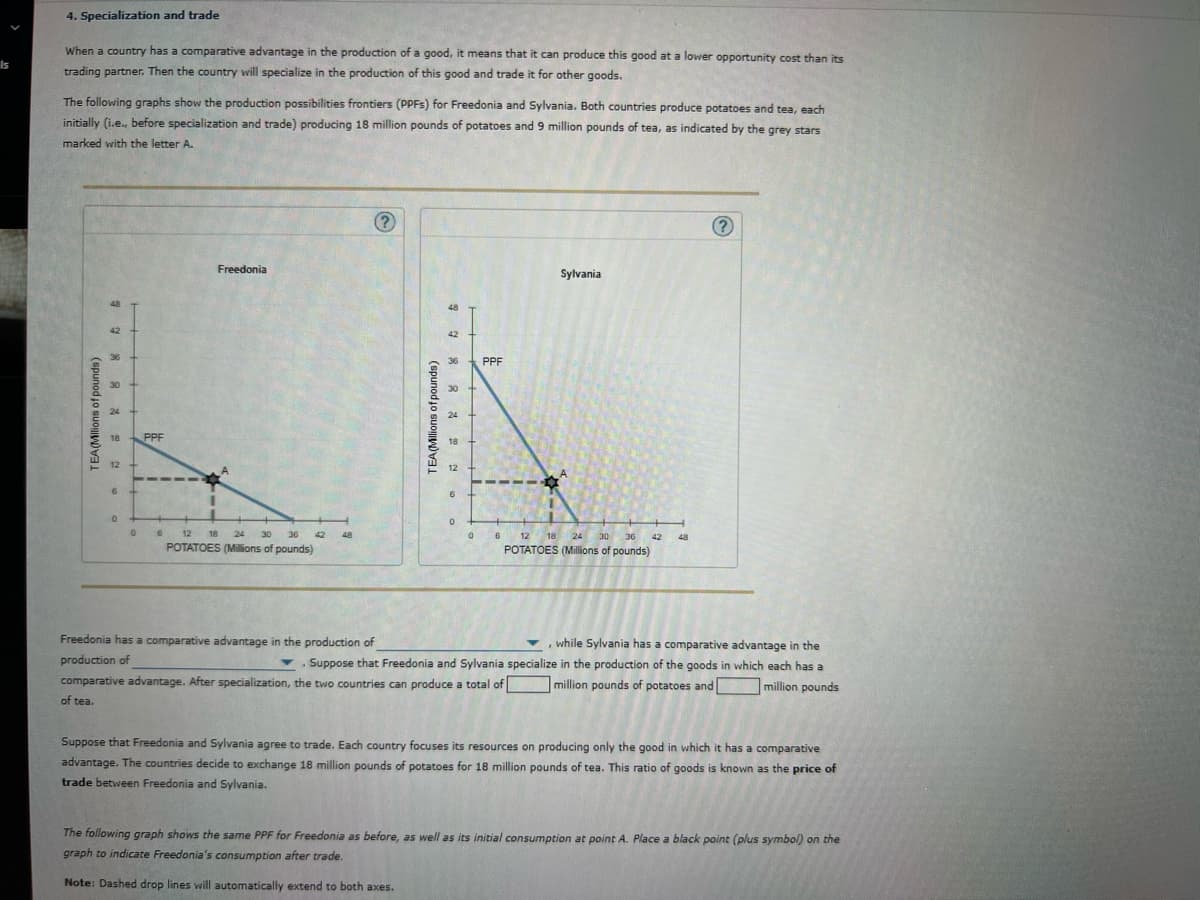4. Specialization and trade When a country has a comparative advantage in the production of a good, it means that it can produce this good at a lower opportunity cost than its Is trading partner. Then the country will specialize in the production of this good and trade it for other goods. The following graphs show the production possibilities frontiers (PPFS) for Freedonia and Sylvania. Both countries produce potatoes and tea, each initially (i.e., before specialization and trade) producing 18 million pounds of potatoes and 9 million pounds of tea, as indicated by the grey stars marked with the letter A. Freedonia Sylvania 48 48 42 42 36 36 PPF 30 30 24 24 18 PPF 18 12 12 ----- 6 12 18 24 POTATOES (Millions of pounds) 30 36 42 12 18 24 30 36 42 48 POTATOES (Millions of pounds) Freedonia has a comparative advantage in the production of v , while Sylvania has a comparative advantage in the production of Suppose that Freedonia and Sylvania specialize in the production of the goods in which each has a comparative advantage. After specialization, the two countries can produce a total of million pounds of potatoes and million pounds of tea. Suppose that Freedonia and Sylvania agree to trade. Each country focuses its resources on producing only the good in which it has a comparative advantage. The countries decide to exchange 18 million pounds of potatoes for 18 million pounds of tea. This ratio of goods is known as the price of trade between Freedonia and Sylvania. The following graph shows the same PPF for Freedonia as before, as well as its initial consumption at point A. Place a black point (plus symbol) on the graph to indicate Freedonia's consumption after trade. Note: Dashed drop lines will automatically extend to both axes. TEA(MIlions of pounds) (spunod jo suoiwyaL
4. Specialization and trade When a country has a comparative advantage in the production of a good, it means that it can produce this good at a lower opportunity cost than its Is trading partner. Then the country will specialize in the production of this good and trade it for other goods. The following graphs show the production possibilities frontiers (PPFS) for Freedonia and Sylvania. Both countries produce potatoes and tea, each initially (i.e., before specialization and trade) producing 18 million pounds of potatoes and 9 million pounds of tea, as indicated by the grey stars marked with the letter A. Freedonia Sylvania 48 48 42 42 36 36 PPF 30 30 24 24 18 PPF 18 12 12 ----- 6 12 18 24 POTATOES (Millions of pounds) 30 36 42 12 18 24 30 36 42 48 POTATOES (Millions of pounds) Freedonia has a comparative advantage in the production of v , while Sylvania has a comparative advantage in the production of Suppose that Freedonia and Sylvania specialize in the production of the goods in which each has a comparative advantage. After specialization, the two countries can produce a total of million pounds of potatoes and million pounds of tea. Suppose that Freedonia and Sylvania agree to trade. Each country focuses its resources on producing only the good in which it has a comparative advantage. The countries decide to exchange 18 million pounds of potatoes for 18 million pounds of tea. This ratio of goods is known as the price of trade between Freedonia and Sylvania. The following graph shows the same PPF for Freedonia as before, as well as its initial consumption at point A. Place a black point (plus symbol) on the graph to indicate Freedonia's consumption after trade. Note: Dashed drop lines will automatically extend to both axes. TEA(MIlions of pounds) (spunod jo suoiwyaL
Principles of Macroeconomics (MindTap Course List)
7th Edition
ISBN:9781285165912
Author:N. Gregory Mankiw
Publisher:N. Gregory Mankiw
Chapter3: Interdependence And The Gains From Trade
Section: Chapter Questions
Problem 9PA
Related questions
Question
Practice Pack
The two drop bar options are (potatoes, tea, neither potatoes nor tea, both potatoes and tea)

Transcribed Image Text:The fallowing graph shows the saYne PPF for reesonia an befure, as well as its initial consumption at point A. Place a black point (plus symibol) an the
graph to indicate Freedonia's CEVISurption after trade.
Note: Dashed drop lines will automatically extend to boti xes.
Freedonla
Consumpaon Aher Trade
PPF
12
18
24
42
POTATOES Miions of pounds)
The following graph shows the same PPF for Sylvania as before, as well as its initial consumption at point A.
As you did for Freedonia, place a black point (plus symbol) on the folowing graptr to indicate Sylvanie's consumption after trade.
Sylvanla
Consumpnon After Trade
PPF
12
18
24
30
42
POTATOES (Milions of pounds)
True or False: Wilhout engaging in initernational trade, Freedunia and Sylvania woukl have been able to consume at the after-trade consumption
bundles. (Hint: Base this qustion on the ariswers you preyiously entered on this page.)
O True
O ralse
(spuned o suauur)vau
TEA (Milons of pouncs)

Transcribed Image Text:4. Specialization and trade
When a country has a comparative advantage in the production of a good, it means that it can produce this good at a lower opportunity cost than its
Is
trading partner. Then the country will specialize in the production of this good and trade it for other goods.
The following graphs show the production possibilities frontiers (PPFS) for Freedonia and Sylvania. Both countries produce potatoes and tea, each
initially (i.e., before specialization and trade) producing 18 million pounds of potatoes and 9 million pounds of tea, as indicated by the grey stars
marked with the letter A.
Freedonia
Sylvania
48
48
42
42
36
36
PPF
30
30
24
24
18
PPF
18
12
12
3111
6 12 18 24 30
POTATOES (Millions of pounds)
36
42
12
18
24
30
36
42
48
POTATOES (Millions of pounds)
Freedonia has a comparative advantage in the production of
v, while Sylvania has a comparative advantage in the
production of
Suppose that Freedonia and Sylvania specialize in the production of the goods in which each has a
comparative advantage. After specialization, the two countries can produce a total of
million pounds of potatoes and
million pounds
of tea.
Suppose that Freedonia and Sylvania agree to trade. Each country focuses its resources on producing only the good in which it has a comparative
advantage. The countries decide to exchange 18 million pounds of potatoes for 18 million pounds of tea. This ratio of goods is known as the price of
trade between Freedonia and Sylvania.
The following graph shows the same PPF for Freedonia as before, as well as its initial consumption at point A. Place a black point (plus symbol) on the
graph to indicate Freedonia's consumption after trade.
Note: Dashed drop lines will automatically extend to both axes.
TEA(MIlions of pounds)
(spunod j0 suoiwyaL
Expert Solution
This question has been solved!
Explore an expertly crafted, step-by-step solution for a thorough understanding of key concepts.
This is a popular solution!
Includes step-by-step video
Trending now
This is a popular solution!
Learn your way
Includes step-by-step video
Step by step
Solved in 3 steps with 1 images

Knowledge Booster
Learn more about
Need a deep-dive on the concept behind this application? Look no further. Learn more about this topic, economics and related others by exploring similar questions and additional content below.Recommended textbooks for you

Principles of Macroeconomics (MindTap Course List)
Economics
ISBN:
9781285165912
Author:
N. Gregory Mankiw
Publisher:
Cengage Learning

Principles of Economics, 7th Edition (MindTap Cou…
Economics
ISBN:
9781285165875
Author:
N. Gregory Mankiw
Publisher:
Cengage Learning

Principles of Microeconomics (MindTap Course List)
Economics
ISBN:
9781305971493
Author:
N. Gregory Mankiw
Publisher:
Cengage Learning

Principles of Macroeconomics (MindTap Course List)
Economics
ISBN:
9781285165912
Author:
N. Gregory Mankiw
Publisher:
Cengage Learning

Principles of Economics, 7th Edition (MindTap Cou…
Economics
ISBN:
9781285165875
Author:
N. Gregory Mankiw
Publisher:
Cengage Learning

Principles of Microeconomics (MindTap Course List)
Economics
ISBN:
9781305971493
Author:
N. Gregory Mankiw
Publisher:
Cengage Learning

Principles of Economics (MindTap Course List)
Economics
ISBN:
9781305585126
Author:
N. Gregory Mankiw
Publisher:
Cengage Learning

Principles of Microeconomics
Economics
ISBN:
9781305156050
Author:
N. Gregory Mankiw
Publisher:
Cengage Learning

Principles of Macroeconomics (MindTap Course List)
Economics
ISBN:
9781305971509
Author:
N. Gregory Mankiw
Publisher:
Cengage Learning